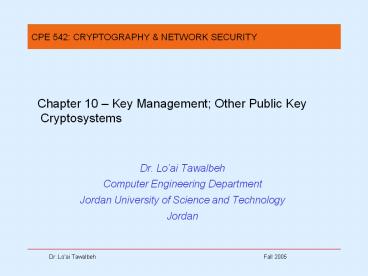Dr. Lo - PowerPoint PPT Presentation
Title: Dr. Lo
1
Chapter 10 Key Management Other Public Key
Cryptosystems
CPE 542 CRYPTOGRAPHY NETWORK SECURITY
- Dr. Loai Tawalbeh
- Computer Engineering Department
- Jordan University of Science and Technology
- Jordan
2
Diffie-Hellman Key Exchange
- By Deffie-Hellman -1976
- is a practical method for public exchange of a
secret key - used in a number of commercial products
- value of key depends on the participants (and
their private and public key information) - based on exponentiation in a finite (Galois)
field (modulo a prime or a polynomial) - security relies on the difficulty of computing
discrete logarithms (similar to factoring) hard
3
Diffie-Hellman Setup
- all users agree on global parameters
- large prime integer or polynomial q
- a a primitive root mod q
- each user (eg. A) generates their key
- chooses a secret key (number) xA lt q
- compute their public key yA axA mod q
- each user makes public that key yA
4
Diffie-Hellman Key Exchange
- shared session key for users A B is KAB
- KAB axA.xB mod q
- yAxB mod q (which B can compute)
- yBxA mod q (which A can compute)
- KAB is used as session key in private-key
encryption scheme between Alice and Bob - if Alice and Bob subsequently communicate, they
will have the same key as before, unless they
choose new public-keys - attacker needs an x, must solve discrete log
5
Diffie-Hellman Key Exchange
6
Diffie-Hellman Example
- users Alice Bob who wish to swap keys
- agree on prime q353 and a3
- select random secret keys
- A chooses xA97, B chooses xB233
- compute public keys
- yA397 mod 353 40 (Alice)
- yB3233 mod 353 248 (Bob)
- compute shared session key as
- KAB yBxA mod 353 24897 160 (Alice)
- KAB yAxB mod 353 40233 160 (Bob)
7
Elliptic Curve Cryptography
- majority of public-key crypto (RSA, D-H) use
either integer or polynomial arithmetic with very
large numbers/polynomials - imposes a significant load in storing and
processing keys and messages - an alternative is to use elliptic curves
- offers same security with smaller bit sizes
8
Real Elliptic Curves
- an elliptic curve is defined by an equation in
two variables x y, with coefficients - consider a cubic elliptic curve of form
- y2 x3 ax b
- where x,y,a,b are all real numbers
- also define zero point O
- have addition operation for elliptic curve
- geometrically sum of QR is reflection of
intersection R
9
Real Elliptic Curve Example
10
Finite Elliptic Curves
- Elliptic curve cryptography uses curves whose
variables coefficients are finite - have two families commonly used
- prime curves Ep(a,b) defined over Zp
- use integers modulo a prime
- best in software
- binary curves E2m(a,b) defined over GF(2n)
- use polynomials with binary coefficients
- best in hardware
11
Elliptic Curve Cryptography
- ECC addition is analog of modulo multiply
- ECC repeated addition is analog of modulo
exponentiation - need hard problem equiv to discrete log
- QkP, where Q,P belong to a prime curve
- is easy to compute Q given k,P
- but hard to find k given Q,P
- known as the elliptic curve logarithm problem
- Certicom example E23(9,17)
12
ECC Diffie-Hellman
- can do key exchange analogous to D-H
- users select a suitable curve Ep(a,b)
- select base point G(x1,y1) with large order n
s.t. nGO - A B select private keys nAltn, nBltn
- compute public keys PAnAG, PBnBG
- compute shared key KnAPB, KnBPA
- same since KnAnBG
13
ECC Encryption/Decryption
- several alternatives, will consider simplest
- must first encode any message M as a point on the
elliptic curve Pm - select suitable curve point G as in D-H
- each user chooses private key nAltn
- and computes public key PAnAG
- to encrypt Pm CmkG, Pmk Pb, k random
- decrypt Cm compute
- PmkPbnB(kG) Pmk(nBG)nB(kG) Pm
14
ECC Security
- relies on elliptic curve logarithm problem
- fastest method is Pollard rho method
- compared to factoring, can use much smaller key
sizes than with RSA etc - for equivalent key lengths computations are
roughly equivalent - hence for similar security ECC offers significant
computational advantages































